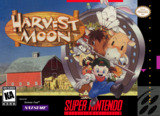Harvest Moon proves that tending a farm can become a very satisfying game premise.
Far from being your ordinary Super Nintendo game back in 1997, Harvest Moon mixed the RPG genre with a location that would be least associated with electronic entertainment: a farm. It went on to become one of Natsume's best-selling series, on multiple platforms.
The premise of Harvest Moon is pretty simple, at first - you are a city kid who happens to wander upon a farmer who decides to pass away his run down farm to you, with one condition, that you make it profitable in an year. At the beginning, after getting introduced to the townsfolk that live right next to the farm, you're set free to do whatever you want with the land you received. Each day consists of a 12 hour shift that roughly takes ten real minutes to pass - in that period, crops have to be planted or watered, cows and chickens have to be tended and eventual visits to town and the outskirts have to be made. Days also have random weather effects, like rain, sun or even snow. These can be previewed at the TV located in the main farm house, which will always have a perfect weather cast for the next day. Seasons also play a part in the weather, with more dangerous effects as the year progresses, like tornadoes and snow storms. These weather changes aren't just for show - animals left outside the barn at night during these events will suffer adverse health problems and not produce for many days. The farm barn plays a special role during the winter, where the cattle and birds will have to be kept fed with gathered grass and fodder.
The initial income choices are limited at first - you get to choose from two types of seeds to plant and grow. Your selection of tools makes the job much easier, since you'll have to clear the land of scattered rocks with the help of a hammer, and bushes with a hatchet. Then, in order to be able to plant the seeds for your crops, you'll also have to rake the soil and irrigate these plants. Two of these tools can be carried at a time, and as long as you continually use them, they'll become more powerful. More instruments can be bought at the town's various stores, like an irrigation system to cover more squares of crop, or a brush to clean your cows, making them happier and produce better graded milk.The amount of work done during the days is limited to the physical labor you put your character through, which can be extended if you manage to find special power berries hidden within the farm soil.
Everyday, at dusk, the local shipper comes by to pick up whatever you put in your delivery basket by the farm's entrance, leaving the money earned. The amount you receive depends on the types of crops and produce you gather during the day - cheaper seeds for vegetables bought at the seed shop, like turnips, will grow in a faster rate that will earn you less than tomato seeds, that take longer to grow, but with a larger income, just like chicken eggs picked everyday won't earn as much as a jar of milk from a healthy cow.
A steady income will be vital in order to progress from simple crops to tending cattle, and to the eventual renovation of the farm. This renovation can be contracted once you amass the amount of money needed, and will be necessary in order to evolve the main character's personal life. Eventually, this will extend to his family, since amongst the town's bachelor women, a special lady can be impressed and charmed in a variety of ways, becoming his wife. Other events, like seasonal festivals, also keep the days from becoming monotonous, although they are a bit scattered throughout the in-game year.
Considering that most copies of Harvest Moon found at auction websites then to circulate at around the one hundred dollar price tag, 800 Wii Points, around eight dollars is a very good deal. It'll keep you busy 'til the cows come home.

